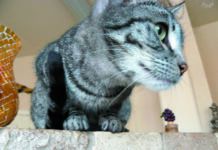[From Tufts January 2011 Issue]
Frustrated by cat’s asthma treatments
My 10-year-old cat, Cassie, was diagnosed last year with asthma. The veterinarian has never seen her have an attack, but based on my description of it, she agreed it must be asthma. An X-ray of her lungs proved inconclusive.
We first tried an inhaler (with Flovent) prescribed “as needed,” but over time, Cassie needed daily doses. Because I didn’t want to subject her to the inhaler every day, we started giving her oral doses of prednisone suspension malt daily instead. This medication did little good and Cassie continued to have asthma attacks almost daily.
Now we’re trying injections of methylprednisolone acetate. Originally, my veterinarian prescribed administering the injection every 60 days and taught me how to give the injections at home. However, Cassie has not been able to go 60 days without an attack, and when I asked the veterinarian if we could give her shots more often, I was told it was OK as long as I didn’t give it to her every week. So, recently, because Cassie was having attacks just three weeks after her last shot, I gave her another shot. Two days later she had an attack, and again six days after that experienced a quite severe attack.
I’m concerned that she is not improving and I have begun to wonder if she does, indeed, have asthma. However, when I put my ear close to her chest/throat area immediately after an attack, I can hear a gurgling noise.
Cassie has a predilection for gaining weight and I understand one of several potential side effects of methylprednisolone is weight gain, so I’m concerned about ramping up the injection schedule. Any insights or advice you can give will be greatly appreciated.
Tracie Hornung
Dear Tracie: Asthma in humans is a lower airway disease that causes people to cough and wheeze and limits their ability to exercise. These clinical signs occur because the airways in asthmatic humans are hyper-reactive and may undergo spontaneous constriction when exposed to certain stimuli.
A remarkably similar condition exists in cats. Asthmatic cats experience recurrent bouts of coughing, wheezing and labored breathing. The condition affects approximately 1 percent of the general cat population, and about 5 percent of Siamese cats. Some cats have only a brief history of coughing episodes before presenting with acute, severe respiratory compromise, the so-called “asthma attack.” When not having episodes of coughing or wheezing most cats behave completely normally.
It certainly sounds like your cat is experiencing asthma, but sometimes it’s not an easy disorder to diagnose. There are no simple laboratory tests that can diagnose feline asthma with 100 percent certainty. A diagnosis is usually made based on the history, physical examination findings, and X-rays of the chest. Radiographs (X-rays) provide the most information for veterinarians presented with a coughing cat. Identification of thickened air passages (seen as “doughnuts” and “train tracks” on an X-ray) is the most important radiographic finding in a diagnosis of feline asthma. Other helpful tests include a complete blood count and a heartworm test. Occasionally, if clinical signs, X-rays and blood tests are ambiguous, other tests such as bronchoscopy may be necessary. Bronchoscopy involves the use of an instrument with a tiny fiberoptic camera (the bronchoscope) to examine the inside of the lungs and collect specimens for cytology or biopsy. Because the X-rays of your cat were inconclusive, I think you should consider bronchoscopy to obtain a definite diagnosis.
The ideal treatment of asthma would be to limit the cat’s exposure to the offending allergen, however, it is often impossible to definitively determine which allergen is triggering the attack. People should not smoke or apply perfume around asthmatic cats and litters emitting dust should be avoided.
The most effective long-term treatment of feline asthma is high-dose corticosteroids. Prednisone given at high doses for two weeks and then slowly tapered down to every-other-day therapy remains the most consistent, reliable and effective treatment for asthma in cats, although it sounds like oral prednisolone isn’t very effective for your cat.
Bronchodilators are drugs that reverse airway constriction, allowing the air passages to open. Bronchodilators may be used as adjunct therapy, but they shouldn’t be used as sole treatment. Chronic inflammation is the root of the problem and treatment of this inflammation using steroids is the cornerstone of therapy. Talk to your veterinarian about adding a bronchodilator to your drug regimen.
Long-acting steroid injections may be given, however, this is a less desirable approach to treatment as these injections vary in how long they last (anywhere from three weeks to three months) and may be associated with side effects such as transient diabetes. When the effects of the injection wear off, the clinical signs usually return. You need to stop the steroid injections. Your cat, with a propensity for weight gain, is a ticking time bomb for diabetes.
In recent years, inhalers have become popular. Inhaled drugs relieve symptoms of asthma much faster than oral or injectable drugs. Inhaled steroids are the most potent inhaled anti-inflammatory drugs available. Inhaled steroids like fluticasone (Flovent) are of a large molecular size and thus do not pass into the bloodstream when inhaled. As a result, they do not cause the unwanted side effects that the pills or injections do. Many cat owners find that giving inhaled steroids is faster and seems to bother the cat less than trying to administer oral medication. You said that you didn’t want to subject your cat to the inhaler every day, but you didn’t say why. Was she not tolerating the procedure? I think you should reconsider using inhaled steroids again, twice daily, in combination with a bronchodilator.
Feline asthma is not a curable disease, however, recent advances in our understanding of the disorder have allowed veterinarians to devise more effective treatment plans and cats are breathing a little easier as a result.
Arnold Plotnick, DVM
Catnip Medical Director



